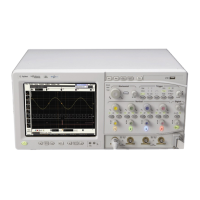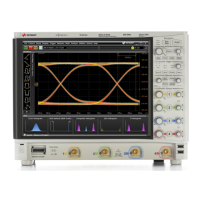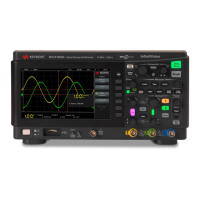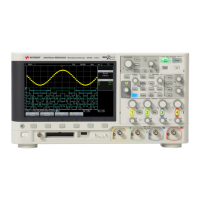Chapter 8: Theory of Operation
Attenuator Theory
155
Attenuator Theory
The channel input signals are conditioned by the channel attenuator assemblies. There
are four completely independent attenuators on each assembly, but one channel can be
routed in the preamp/multiplexer hybrid to drive both channel outputs for sample rate
doubling purposes. Each channel contains passive attenuators, an impedance converter,
and a programmable gain amplifier. There are two identical outputs for each channel:
one to drive the ADC hybrids and one to drive the trigger circuitry.
After the passive attenuators, the signal is split into high- frequency and low- frequency
components. Low- frequency components are amplified on the main assembly where
they are combined with the offset voltage. The AC coupling is implemented in the low-
frequency amplifier.
The high- and low- frequency components of the signal are recombined and applied to
the input FET of the impedance converter. The FET provides a high impedance load
for the input attenuators and a low impedance drive for a buffer, which drives 50 Ω.
Acquisition Theory
The acquisition system includes two major sections. One is the acquisition board, which
conditions, stores, and processes the input signals. The other is the A1 interface board,
which provides the interface from the acquisition to the motherboard and display, and
also interfaces the motherboard to the front- panel keyboard.
Acquisition Board
The acquisition circuitry samples, digitizes, and stores the signals from the channel
attenuators. The four channels are identical. The trigger signals synchronize acquisition
through the trigger and time base circuitry. A reference oscillator and the time base
provide the base sample rates.
ADC The Keysight Technologies Infiniium Oscilloscope ADC provides all of the
sampling, digitizing, and high- speed waveform storage. Each ADC contains two 2
GSa/s ADCs. They can be run in phase to increase resolution, or out- of- phase to
sample at 4 GSa/s. The ADC includes a delay- locked loop to synchronize the sample
clock to the 125 MHz timebase reference clock. For sample rates < 2 GSa/s, data
is decimated.
Trigger There are four main trigger circuits: Trigger Conditioning, Analog
Comparators, a Trigger Multiplexer, and Logic Trigger. Trigger signals from the
channel are fed to the analog trigger comparators and the trigger conditioning circuit.
The trigger conditioning circuitry selects DC, ac, low- frequency reject, high-frequency
reject, and noise reject (hysteresis) modes and sets the trigger levels. The trigger
multiplexer selects the trigger modes, such as edge, glitch, and pattern trigger.
The channel triggers are sent to the Logic Trigger. The logic trigger provides the advanced
triggering functions, such as holdoff, delay, and pattern duration and range. The data
delay and clock delay timers are used to implement trigger functions that require timing
between 1.5 and 20 ns.
The auxiliary trigger, which cannot be displayed on screen, is compared to the trigger
level setting in a separate circuit. The line sync trigger line from the power supply is
combined in a multiplexer with the TV trigger and the high frequency reject comparators
before being sent to the analog trigger.

